An accident of products with explosives might lead to a
fragmentation of fissile materials (FM) and formation of both small (less than
100 microns) and larger particles (fragments). During the expansion process,
the interaction of high-speed particles with the products of the explosion (EP)
causes their thermochemical destruction and the formation of smaller particle-fragments,
which makes an additional contribution to the spectrum of fine particles.
Experimental data on the spectrum of additionally formed particles during the interaction
of FM and EP fragments is necessary to determine their contribution to the radioactive
pollution of the district and to develop technical decisions how to reduce radiation
consequences for similar accidents.
Experiments with the specimens (models) containing FM are expensive
and pose the environmental hazard. Therefore, a methodology to study the
dispersion of FM in emergency situations involving the explosion and simulating
FM is developed, and it allows to determine the contribution of high-speed
fragments of FM in the General spectrum distribution. The way to simulate the
properties of plutonium using a simulator material (cerium metal) (which
behaves similarly to FM when it is exposed to hypersonic airflow) is
environmentally safe (patent RF ¹ 2298850). To solve the problems of studying
aerosols from FM simulators, techniques have been developed which allow
throwing a group of solid parallelepiped shaped particles with the sizes from 1.4*0.8*0.9
to 1.4*0.8*1.1 mm with hypersonic velocities and to carry out optical
non-contact registration of this group and aerosols formed from the solid
particles of this group in while flying. Initial experimental studies have
shown that the flight of particles of the FM simulator in the air atmosphere
with an initial velocity of ~3000 m/s causes thermomechanical particles destruction
in the solid state with the formation of a large number of particles due to
their oxidation during heating and braking in the incoming high-enthalpy flow.
Thus, it has become necessary to develop an optical non-contact way
to register these particles.
1. Shadow scheme with selective range of photorecording.
Pulsed light sources with gas-discharge and tube emitters are widely
used in optical registration practice [1]. The main advantage of these light
sources is that they have a high brightness temperature and a wide range of
radiation with the maximum at ultraviolet.
Today, despite the active transition to digital technology, there
are still tasks at which photographic materials are used. Isoperational film
has photosensitivity most fully overlapping a visible emission spectrum. The
maximum sensitivity remains at the ultraviolet region (Fig. 1).

Fig. 1 – Photosensitivity curves for differently sensitized
photographic materials
The classical scheme of a shadow image construction is a scheme where
a point source of radiation (the size of the glow body is much smaller than the
distance to the screen) builds a shadow picture from the test object (OI) in
divergent rays on a photosensitive material (film, photo paper or photographic
plate) [2-12]. At the same time, due to the dependence of the refractive index
on the density, the angle of inclination also changes with the passage of
optical inhomogeneities, which makes it possible to visualize, in particular,
the head shock wave and the turbulent trace of the OI at supersonic speeds on
the photographic material. The main drawback of the photographic material is
that it is a single-use receiver. However, out of all image receivers, it is
still the only one which has both high sensitivity and high resolution.
Application of the classical shadow scheme in the ballistic experiment is not
always possible due to the strong background radiation, for example, during the
intensive process of hypersonic aerodynamic destruction or during the
photo-recording of the intermediate ballistic trajectory of the intermediate
ballistics [13,14]. Improvement of the basic and introduction of additional
elements to the scheme of photo registration allows one to solve similar
problems using the shadow method. The main elements of this scheme are the
light source and the screen (photographic material), the set of their
parameters determines the spatial resolution of the optical scheme. The
sensitivity of the circuit increases proportionally to the distance from the
source to the screen. The shadow picture is more distinct the smaller the light
source and the closer the registration object is to the screen [1]. Since the
use of an open film in the wording of the formulated problem is impossible, to
protect the negative from intense background illumination on a cassette with an
isopanchromatic film, a protective light filter is installed to cut off the background
radiation in the green-red range (the spectrum of background radiation of
combustion and explosion products). Glass filter SS-8 and membrane filter
record have been considered. The distribution of spectral sensitivity of these
filters was measured and is shown on Fig. 2.

Fig. 2-diagram of the spectral sensitivity of the two filters.
Both filters have similar parameters, film area of 700 nm or more is
not sensitive, and therefore is not of interest. Given the fact that the gas-discharge
light sources are characterized by a brightness temperature of 10,000 to 30,000
K (ultraviolet-violet region), the use of both filters is optimal. The greatest
transmittance in the range of 350 ÷ 500 nm has a glass filter SS-8, but in
the field test conditions the film filter racord is more applicable. Thus, the
shadow scheme (Fig. 3) consists of a point discharge source 1 with EVIS emitter
[1] with aperture size of 7 mm, which is located in front of the cassette 2
with a large open isoperational film 3 closed by a filter, "record"
5. In addition, specifically for this scheme a light-tight mobile stand of
shadow photo registration 4 with input and output windows for through movement
of the object 6 in the registration area was designed and manufactured.

Fig. 3 – Diagram of the shadow recorder.
To solve these problems, a test procedure was developed, focused on
the use of a 23-millimeter light-gas gun (LGG) as a booster device, which
provides the possibility of throwing a particle with the size of 1,4*0,8*0,9 mm
to 1,4*0,8* 1,1 mm at a speed of 3 km / s. Since the metal particles have a
different size and mass, when leaving the barrel channel and during paraffin
evaporation process (Fig.4) particles fly in a "cloud." Therefore,
the optical registration scheme should have a sufficiently large registration
area (0.5 m) and a high resolution to visualize the particles themselves and
the gas-dynamic pattern accompanying the supersonic motion.
The main difficulty of shadow photo recording was that
it was required to carry out optical diagnostics of the state of the object
being thrown at 3 m from the LGG barrel cut. After the thrown object leavies
the channel of the, its further free flight occurs together with the products
of a ballistic shot (an air - helium mixture with a temperature of about 2000
K), due to the small mass of particles (0.5 mg to 20 mg).

Fig. 4 – tablet of Paraffin, metal particles and leading pallet in
assembled and disassembled conditions
The scheme of equipment placement on the working field together with
LGG is shown in Fig. 5.
The moment of starting the light source is the moment of penetration
of the film contact sensor installed at the exit of the stand by solid
particles which have the lowest ballistic coefficient and, as a consequence,
fly in front.

Fig. 5-Layout of the equipment.
As a result of the test experiments, shadow spectra of the flow of
solid metal particles were obtained,. Their example is shown in figure 6.
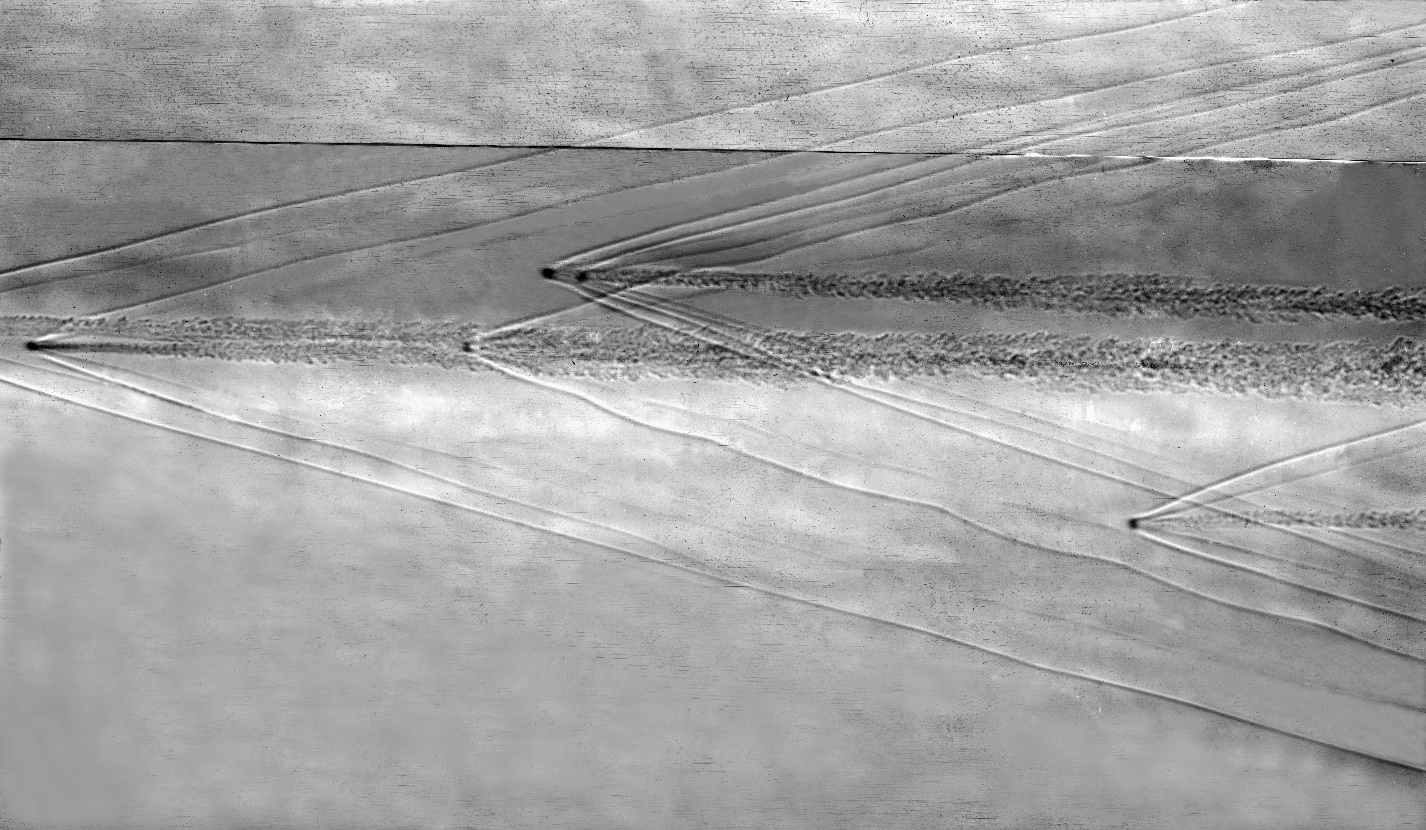
Fig. 6 – Shadow the range of flow of metal particles.
Through the analysis of negatives, the Mach numbers and the fall of
the Mach number of the registered particles on the trajectory section from the
LGG trunk to the center of the registration zone in the shadow stand were
estimated. The ranges of temperature changes at the breaking point, according
to the results of shadow registration, during their flight in the same section
of the trajectory were determined.
The shadow flow spectra obtained in the course of experiments are an
excellent material for verification of numerical simulation methods of high-speed
motion processes of metal particles in gas. In particular, it is possible to
study the flow around a group of particles of different diameters under the
influence of supersonic air flow. Numerical simulation of the process of flow
around solid particles of the material using SolidWorks Flow Simulation [15] is
performed. Three-dimensional calculation of the process of external flow around
the supersonic flow of the compressible gas was carried out taking into account
the relevant boundary conditions, at the entrance to the calculated domains the
boundary conditions for the velocity, the condition of adhesion of the flow –
on the surface of the particles were set. The complete, Reynolds-averaged
Navier-Stokes equations supplemented by a two-parameter turbulence model were
solved.
Several calculated cases corresponding to the flight of bodies of
approximately the same size and significantly different in particle diameter
were considered.
Finite-volume mesh consisted of hexagonal elements, oriented with
respect to the direction of flow of the gas at the inlet to the computational
domain. In areas of the highest gradients of the parameters of the gas produced
adaptation of the mesh by grinding of computational cells. The total number of
cells for the case of the flow of particles of different diameters was about
3.3 million cells, for the flow of particles of the same size-5.7 million
cells. The General view of the finite-volume grid is shown in Fig. 7.
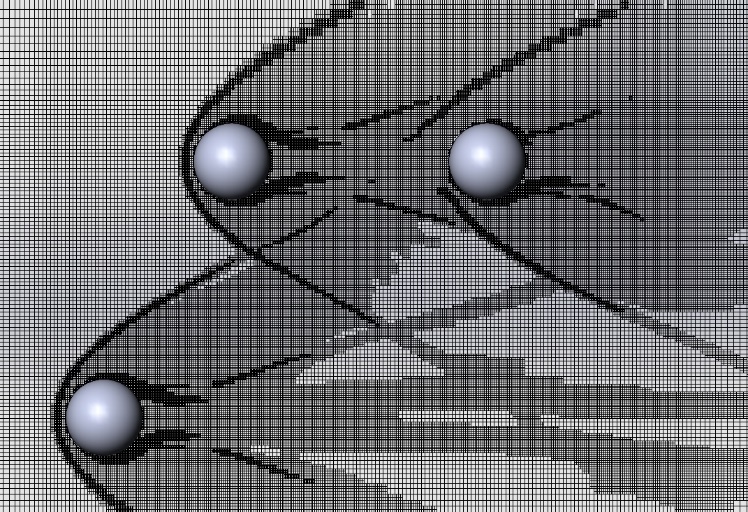
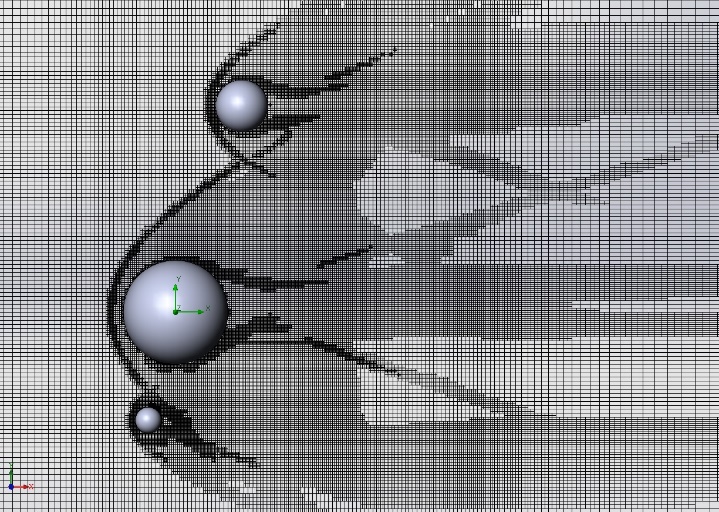
a)
b)
Fig. 7-General view of the adapted finite-volume mesh in the flow simulation
around particles with similar sizes (a) and different diameters (b)
Fig. 8.9 shows the
distribution patterns of velocity and pressure fields for a group of particles with
different and identical sizes in a supersonic gas flow. In general, the flow
pattern corresponds to the data recorded in the experiments.
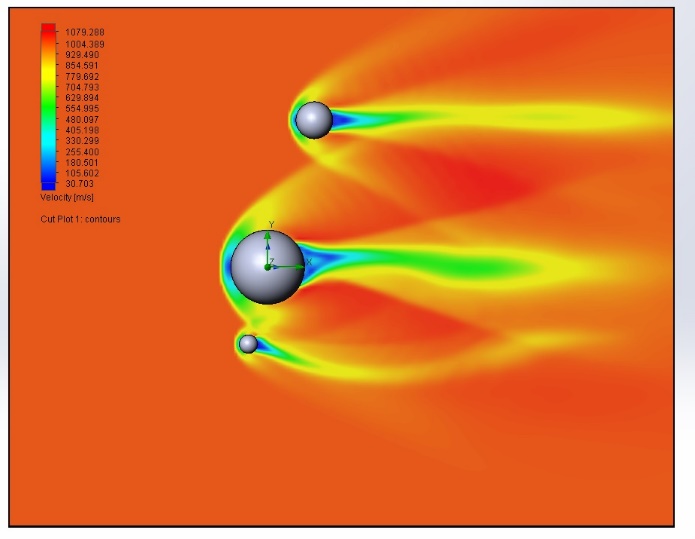

a)
b)
Fig. 8-Distribution of velocity fields (a) and pressure fields (b)
in the gas during flow around a group of particles of different sizes
|
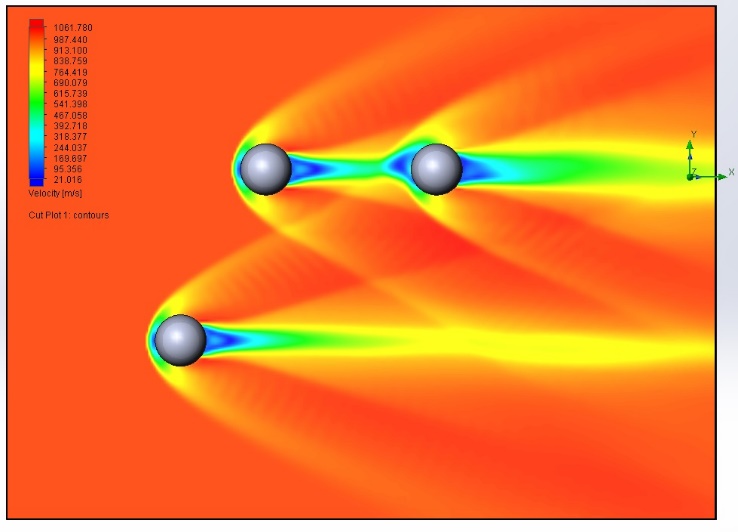
a)
|
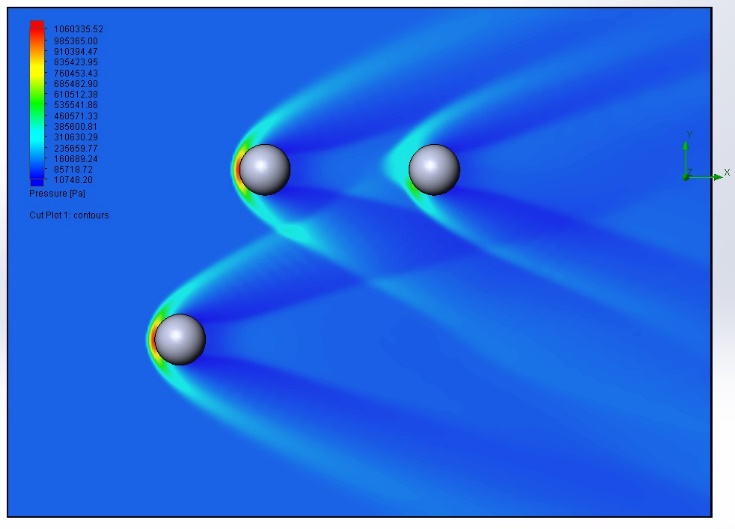
b)
|
Fig. 9-Distribution of velocity fields (a) and pressure fields (b)
in the gas during flow of a group of particles of the same size
According to the experimental data, it was concluded that the flight
of metal particles in the air atmosphere with an initial velocity of ~ 3000 m/s
at a distance of ~ 2.9 m from the cut of the trunk causes intense destruction,
melting and evaporation of the particles.
A shadow scheme with a selective range of photorecording was
developed. Using this scheme, the shadow spectra of particles simulating the
scattering of FM fragments in the event of an accident were obtained.
Analysis of the shadow spectra of the flow around the particles
allowed us to determine some quantitative characteristics:
* estimates of the Mach numbers are obtained for the magnitude of
the angle of inclination of the shock waves from the particles outside the pattern
zone and for two particles in the pattern zone, which were M1 ≈ 4, M2
≈ 2.9 and M3 ≈ 1.5; based on the fact that the velocities of the
registered particles Vi=Mi×a, where a=340 m / s is the speed of sound in
the air, and the calculated value of the initial Mach number is Mlpg≈8.8,
it is possible to estimate the mass-geometric characteristics of the particles
whose shock waves are visible on the shadow spectrum;
* the sizes of particles in the field of photography are estimated
(R1≈0.30 mm-particles flying in front and outside the field of
photography; R2≈0.17 mm-particle flying in front and in the field of
photography; R3≈0.11 mm-particle flying behind and in the field of
photography). Numerical simulation of the process is carried out.
The work is executed with the support of RFFI grants 17-08-01096,
18-38-00297.
1. Gerasimov S. I., Faykov I., Kholin S. A., Cumulative light
sources. Sarov: RFNC-VNIIEF, 2002, 143 p.
2. Abrukov S. A. Shadow and interference methods of investigation of
optical inhomogeneities. Kazan: KSU publishing House, 1962. 81s.
3. Holder D., North R. Shadow methods in aerodynamics. M.:Mir, S.
1966.179
4. Clamex P., Kinghorn M. Development of measurement techniques for
hypersonic ballistic units// Technique hypersonic research.M.-L.: Mechanical
Engineering, 1964. P. 124-198
5. Merkirch W. Flow Visualization. New York, London: Academic Press,
1974. 250p.
6. Vasiliev L. A. Shadow methods. M.: Science, 1968. 400s
7. Gerasimov S. I., Chikeev V. A., Lvova E. A., Tatashev K. V.,
Gerasimov V. R. Spectra of the flow of bodies moving with supersonic speed aerodynamic
research. Bulletin of the national research nuclear University MEPhI, 2016,
vol. 5, No. 4, pp. 289-293.
8. G. Settles Historical Background-Schlieren and shadowgraph
techniques, 2001
9. G. Settles Schlieren and shadowgraph techniques - Visualizing phenomena
in transparent media(Book) - Berlin, Germany: Springer-Verlag GmbH, 2001.
10. Dubnishchev, Arbuzov V. A., Belousov p. P. and others. Optical
methods of research of streams. Novosibirsk: publishing house of Sibir. UN-TA,
2003. 410s.
11. Belozerov Optical methods of visualization of gas flows. Kazan
publishing house. State. Tech. UN-TA, 2007. 747s.
12. Emelyanov V. N., Teterina I. V., Volkov K. N. Visualization of
data of physical and mathematical modeling in gas dynamics. [In] 2018, 360s.
13. Gerasimov S. I., V. I. Erofeev, I. I. Kanygin, A. V. Salnikov,
R. V. Gerasimov Visualization of muzzle exhaust at a shot from a light-gas gun.
Scientific visualization. Vol. 6, ¹2, 2014.
14. Gerasimov S.I., Erofeev V.I., Kikeev V.A., Fomkin A.P. Various
mechanisms of destruction of bodies in hypersonic flow, identified by
radiographic registration. Scientific visualization, vol. 7, No. 1, 2015,
pp38-44.
15. https://www.solidworks.com/product/solidworks-flow-simulation
.












